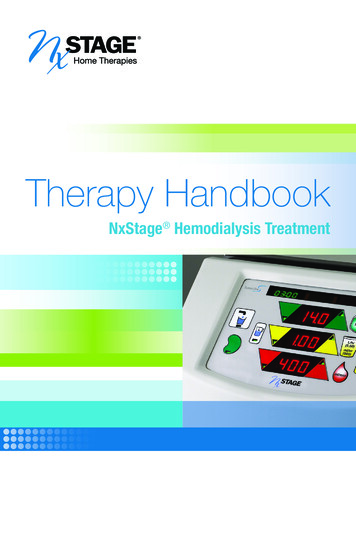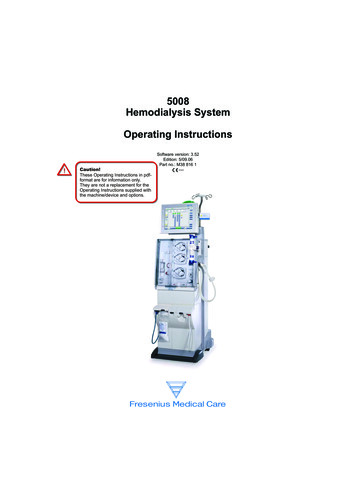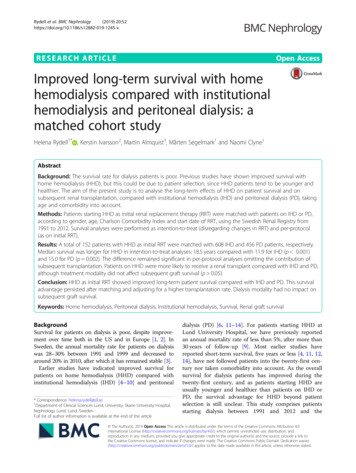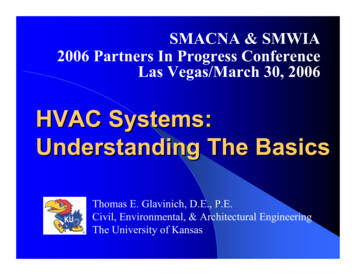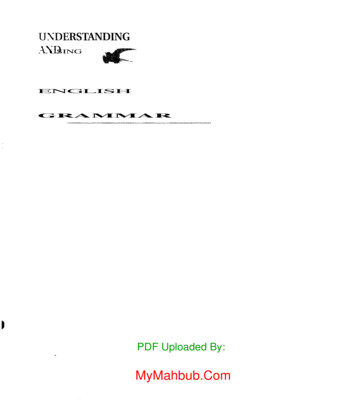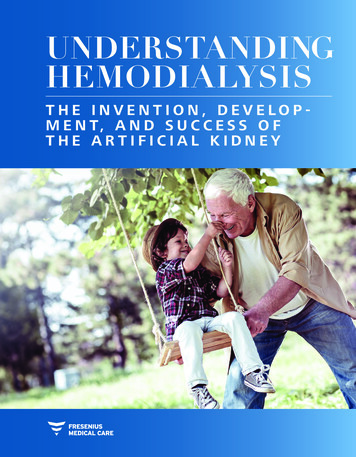
Transcription
UNDERSTANDINGHEMODIALYSISTHE INVENTION, DEVELOPM E N T, A N D S U C C E S S O FTHE ARTIFICIAL KIDNEY
FRESENIUS MEDICAL CARE3Hemodialysis –from the early days to today4Historical basis ofhemodialysis5Hemodialysis6The early days of dialysis8The first successful dialysis treatment9The rotating drum kidney10Dialysis and ultrafiltration11Further developments12Vascular access and chronic dialysis14Modern hemodialysisCONTENTSCONTENTS2
H E M O D I A LY S I S –F R O M T H E E A R LY D A Y S T O T O D A YEDITORIAL3The first signs of uremia within the human body are an indicationthat the kidneys are no longer performing or are unable to completelyfulfill their function. The Greek origin of the word shows that theknowledge of the condition is much older than the ability to treat thislife-threatening problem.It was not until the 1940s that researchers finally established a scientific basis advanced enough to support the first therapeutic trials.The discoveries and inventions of dedicated doctors and scientists areto thank for the advances that have cleared the way for continuoustechnological improvement over the decades.THE CLEANING PROCESS INV O L V E D I N H E M O D I A LY S I S I SCONTROLLED BY CUTTINGE D G E D I A LY S I S M A C H I N E S .FRESENIUS MEDICAL CAREThis brochure looks at thedevelopment of hemodialysisand the artificial kidney (dialyzer) – inventions that helpsecure the life and quality oflife of millions of hemodialysis patients worldwide.
HISTORICAL BASIS4HISTORICAL BASISO F H E M O D I A LY S I SAcute and chronic kidney failure, which can lead to death if untreated for severaldays or weeks, is an illness that is as old as humanity itself. In early Rome and laterin the Middle Ages, treatments for uremia included the use of hot baths, sweatingtherapies, bloodletting, and enemas. Current procedures for the treatment of kidneyfailure include physical processes such as osmosis and diffusion, which are widespread in nature and assist in the transport of water and dissolved substances.The first scientific descriptions of these procedurescame from the Scottish chemist Thomas Graham,who became known as the “Father of Dialysis.” Atfirst, osmosis and dialysis became popular as methods used in chemical laboratories that allowed theseparation of dissolved substances or the removalof water from solutions through semipermeablemembranes. Far ahead of his time, Graham indicatedin his work the potential uses of these procedures inmedicine.Manuscript of ThomasGraham’s “Bakerian Lecture”on “Osmotic Force” at theRoyal Society in London in1854.Today hemodialysis describes an extracorporealprocedure, or procedure outside the body, for filtering uremic substances from the blood of patientssuffering from kidney disease. The actual purifyingprocess, which requires the use of a semipermeableFRESENIUS MEDICAL CAREmembrane, is based on the seminal work carried outby Graham, Fick, and others.
H E M O D I A LY S I SHemodialysis is the process of cleaning blood outside the body, and involves takingH E M O D I A LY S I S5blood from a blood vessel and passing it through a synthetic filter, known as a dialyzer. The blood is cleaned in the dialyzer before being returned to the body, which iswhy the dialyzer is also referred to as an “artificial kidney.” The process is controlledby a dialysis machine, which pumps the blood around the circuit, adds in an anticoagulant, and regulates the cleaning process, among other things. Hemodialysis usuallytakes around three to six hours and is performed at least three times a week, usuallyin a dialysis center.Instead of being treated in a dialysis center, patients may be offered the option ofreceiving treatment in their own home environment. Various types of home dialysisgive patients the opportunity to make their treatment part of their everyday life.AnticoagulantBlood pumpBlood from the patientHEMODIALYSISDialyzer(filter)Freshdialysis fluidBlood to the patientFRESENIUS MEDICAL CAREUseddialysis fluid
T H E E A R LY D A Y S6T H E E A R LY D A Y S O F D I A LY S I SThe first historical description of this type of procedure was published in 1913.Abel, Rowntree, and Turner “dialyzed” anesthetized animals by directing their bloodoutside the body and through tubes of semipermeable membranes made fromCollodion, a material based on cellulose. It is impossible to say for sure whetherAbel and his colleagues intended to use this procedure to treat kidney failure fromthe start. There is no doubt, however, that dialysis treatment today continues to usemajor elements of Abel’s vividiffusion machine.Before the blood could be routed throughthe “dialyzer,” its ability to clot or coagulate had to be at least temporarilyinhibited. Abel and his colleagues used asubstance known as hirudin, which hadbeen identified as the anticoagulant element in the saliva of leeches in 1880.A German doctor by the name of GeorgHaas, from the town of Giessen nearFrankfurt am Main, performed the firstVividiffusion machine from Abeland colleagues, 1913dialysis treatments involving humans. It isbelieved that Haas dialyzed the first patientwith kidney failure at the University ofGiessen in the summer of 1924, after performing preparatory experiments. By 1928,FRESENIUS MEDICAL CAREHaas had dialyzed an additional six patients, none of whom survived, likely becauseof the critical condition of the patients and the insufficient effectiveness of the dialysis treatment. The Haas Dialyzer, which also used a Collodion membrane, was builtin a variety of models and sizes.
T H E E A R LY D A Y S7Dr. Georg Haas performing dialysis on a patient at the University of GiessenHaas, like Abel, also used hirudin as the anticoagulant inH E PA R I Nhis first dialysis treatments. However, this substance oftenis a universalanticoagulantsubstance administered duringhemodialysis toslow bloodcoagulation.led to massive complications arising from allergic reactionsbecause it was not adequately purified and originatedfrom a species very distant from humans. In the end, Haasused heparin in his seventh and final experiment. Heparinis the universal anticoagulant in mammals. This substancecaused substantially fewer complications than hirudin –produced in much larger amounts. Following the development of better purification methods in 1937, heparin wasadopted as the necessary anticoagulant, and continues tobe used today.FRESENIUS MEDICAL CAREeven when it was insufficiently purified – and could be
F I R S T S U C C E S S F U L D I A LY S I S T R E A T M E N T8THE FIRST SUCCESSFULD I A LY S I S T R E A T M E N TIn fall 1945, Willem Kolff,of the Netherlands, made thebreakthrough that had stubbornly eluded Haas. Kolff useda rotating drum kidney hehad developed to perform aweek-long dialysis treatment ona 67-year-old patient who hadbeen admitted to hospital withacute kidney failure. The patientWillem Kolffwas subsequently dischargedwith normal kidney function. This patient proved that the concept developed byAbel and Haas could be put into practice and thus represented the first major breakthrough in the treatment of patients with kidney disease.The success was partially due to the technical improvements in the actual equipment used for the treatment. Kolff’s rotating drum kidney used membranous tubesmade from a new cellulose-based materialknown as cellophane that was actuallyused in the packaging of food. During thetreatment, the blood-filled tubes werewrapped around a wooden drum that rotated through an electrolyte solution knownFRESENIUS MEDICAL CAREas “dialysate.” As the membranous tubespassed through the bath, the laws of physicscaused the uremic toxins to pass into thisrinsing liquid.Kolff rotating drum kidney (1943)
THE ROTATING DRUM KIDNEYExamples of the Kolff rotating drum kidney crossed theAtlantic and arrived at the Peter Brent Brigham Hospitalin Boston, where they underwent a significant technicalimprovement. The modified machines became known asT H E R OTAT I N G D R U M K I D N E Y9the Kolff-Brigham artificial kidney, and between 1954 and1962 were shipped from Boston to 22 hospitals worldwide.practical test under extreme conditions during the KoreanWar. Dialysis treatment succeeded in improving the average survival rate of soldiers suffering from post-traumatickidney failure and thus won time for additional medicalprocedures.Acute dialysis during the Korean War (1952)22H O S P I TA L SWERE EQUIPPEDWITH MODIFIEDARTIFICIALKIDNEYS FROMBOSTON BETWEEN1 9 5 4 A N D 1 9 6 2.FRESENIUS MEDICAL CAREThe Kolff-Brigham kidney had previously passed its
D I A LY S I S A N D U LT R A F I LT R A T I O N10D I A LY S I S A N D U LT R A F I LT R A T I O NOne of the most important functions of the natural kidney, inaddition to the filtering of uremic toxins, is the removal of excesswater. When the kidneys fail, this function must be taken over byD I A LY Z E Rartificial kidneythe artificial kidney, which is also known as a dialyzer.The procedure by which plasma water from the patient is squeezed through the dialyzer membrane using pressure is termed ultrafiltration.In 1947, Swede Nils Alwall published a scientific work describing a modified dialyzerthat could perform the necessary combination of dialysis and ultrafiltration betterthan the original Kolff kidney. The cellophane membranes used in this dialyzer couldwithstand higher pressurebecause of their positioningbetween two protective metalgrates. All the membraneswere in a tightly sealedcylinder so that different pres- South Swedish Society for the History of MedicineFRESENIUS MEDICAL CAREsure ratios could be generated.Nils Alwall in 1946 with an early model of the dialysismachine.
11F U R T H E R D E V E LO P M E N T SFURTHER DEVELOPMENTSBy proving that uremic patients could besuccessfully treated using the artificialkidney, Kolff sparked a flurry of activityaround the world to develop improvedand more effective dialyzers. The “Par South Swedish Society for the History of Medicineallel Plate Dialyzer” evolved as the mostsignificant development of this period.Rather than pumping the blood throughmembranous tubes, this dialyzer directedthe flow of dialysis solution and bloodthrough alternating layers of membranous material. This development beganwith the first Skegg-Leonards dialyzer in1948, and reached its technological peakin 1960 with the presentation of the KiilEarly model of a Kiil dialyzer.dialyzer from Norwegian doctor FredrikKiil. These dialyzers were the predecessors of modern plate dialyzers.Just as the technology of dialyzers continued to develop, so too did the scientificprinciples regarding the transport of substances across membranes, and these principles were applied specifically to dialysis. This work enabled scientists to developa quantitative description of the dialysis process and allowed the development ofFRESENIUS MEDICAL CAREdialyzers with clearly defined characteristics.
V A S C U L A R A C C E S S A N D C H R O N I C D I A LY S I S12VA S C U L A R AC C E S S A N DC H R O N I C D I A LY S I SBelding Scribner made a breakthrough in this field in 1960 in the United States withthe development of what would later become known as the “Scribner shunt.” Thisnew method provided a relatively simple means of accessing a patient’s circulatorysystem that could be used over a period of several months, meaning patients withchronic kidney disease could, for the first time, be treated with dialysis. The shunt wason a small plate that would be attached to the patient’s body, for example on thearm. One Teflon cannula was surgically implanted in a vein and another in an artery.Outside the body, the cannulae were joined in a circulatory short circuit – hence thename “shunt.” During dialysis, the shunt would be opened and attached to the dialyzer. Further development brought the introduction in 1962 of improved shunts madeentirely from flexible materials.Still, the most decisive breakthrough in the field of vascularIn the early 1970s,a dialysis treatmentlasted aroundaccess came in 1966 from Michael Brescia and James Cimino.12 hin the arm with a vein. The vein was not normally exposedTheir work remains fundamentally important to dialysis today. During a surgical procedure, they connected an arteryto high arterial blood pressure and swelled considerably.Needles could then be more easily placed in this vein,which lay beneath the skin, to allow repeated access. This technique lowered the riskof infection and permitted dialysis treatment over a period of years. The arteriovenous(AV) fistula remains the access of choice for dialysis patients, and some AV fistulaFRESENIUS MEDICAL CAREimplanted more than 30 years ago are still in use today.This development allowed the long-term treatment of patients with chronic kidneyfailure. In the spring of 1960, Scribner implanted a shunt in American Clyde Shields,in Seattle. Shields became the first chronic hemodialysis patient, and the dialysis treatments allowed him to live an additional eleven years before dying of cardiac diseasein 1971.
Clyde Shields (1921–1971)Belding H. Scribner (1921–2003)These successes provided a fertile basis for the world’s first-ever chronic hemodial-V A S C U L A R A C C E S S A N D C H R O N I C D I A LY S I S13ysis program, which was established in Seattle in the following years. At that time,Scribner and his team refrained from seeking patent protection for many of theirinventions and innovations to ensure swift distribution of their life-saving techniquesfor dialysis patients.The development of improved methods for accessing blood vessels meant thatpatients with chronic kidney disease could be offered effective treatment for the firsttime. However, in the early 1970s, a dialysis treatment lasted around twelve hoursand was very expensive, due to the high outlay for materials and the treatment itself.As a result, not all kidney patients could access this life-saving therapy. In the UnitedStates, for example, committees decided on how the small number of treatment slotsFRESENIUS MEDICAL CAREshould be allocated – a matter of life-or-death decision-making.
M O D E R N H E M O D I A LY S I S14M O D E R N H E M O D I A LY S I SAfter the early successes in Seattle, hemodialysis established itself as the treatmentof choice worldwide for chronic and acute kidney failure. Membranes, dialyzers,and dialysis machines were continuously improved and manufactured industriallyin ever-increasing numbers. A major step forward was the development of the firsthollow-fiber dialyzer in 1964. This technology replaced the until-then traditionalmembranous tubes and flat membranes with a number of capillary-sized hollowmembranes. This procedure allowed for the production of dialyzers with a surfacearea large enough to fulfill the demands of efficient dialysis treatment. Over theyears that followed, thanks to the development of appropriate industrial manufacturing technologies, it became possible to produce large numbers of disposabledialyzers at a reasonable price. Today, dialyzers are made from entirely syntheticpolysulfone, a plastic that exhibits exceptionally good filtering efficiency and tolerability for patients. They are still based on these technologies.FRESENIUS MEDICAL CARE* A dialyzer incorporates up to 20,000hollow fibers* The walls ofthe hollow fibersin a dialyzer areonly 0.035 mmthickThe current generation of dialyzersproduced by Fresenius Medical Care
M O D E R N H E M O D I A LY S I S15State-of-the-art dialysis machines also monitor patientsto ensure critical conditions can be detected at an earlystage and treated. They feature efficient monitoringand data management systems and have become moreuser-friendly over recent years. A growing number of thelatest generation of dialysis machines also utilize computer-controlled machines, online technologies, networking,and special software.As the clinical use of hemodialysis became increasinglywidespread, scientists were better able to investigate theunique attributes of patients with chronic kidney disease.In contrast to the early years of dialysis presented here,the lack of adequate treatment methods or technologies is no longer a challenge in thetreatment of kidney patients. Thepresent challenges stem rather fromthe large number of patients requiring dialysis treatment, thecomplications resulting from years of dialysis treatment, and apopulation of patients that presentsdemographic as well as medical challenges; a populationwhose treatment would be unimaginable, were it not forthe pioneering work presented here.Up to120liters of blood passthrough the tubesduring dialysistreatmentFRESENIUS MEDICAL CAREof all dialysis patientsare treated withhemodialysisThe 6008 hemodialysismachine from FreseniusMedical Care
Fresenius Medical Care is the world’s leadingprovider of products and services for patientswith kidney disease, millions of whom areundergoing dialysis treatment. We look afterhundreds of thousands of dialysis patients inour global network of dialysis centers.Fresenius Medical Care is also the leadingprovider of dialysis products such as dialysisequipment and dialysis filters. Additionally,in the field of Care Coordination, the companyis expanding its portfolio of supplementarymedical services related to dialysis.Further information about our company and the history of dialysiscan be found online at:www.freseniusmedicalcare.comFRESENIUS MEDICAL CAREElse-Kröner-Str. 161352 Bad Homburg, GermanyThe title, text, and illustrations are protected by copyright. Any type ofuse is prohibited without the consent of Fresenius Medical Care, InvestorRelations & Corporate Communications.
DIALYSIS AND ULTRAFILTRATION DIALYSIS AND ULTRAFILTRATION One of the most important functions of the natural kidney, in addition to the filtering of uremic toxins, is the removal of excess water. When the kidneys fail, this function must be taken over by the artificial kidney, which is also known as a dialyzer.File Size: 1MBPage Count: 16

